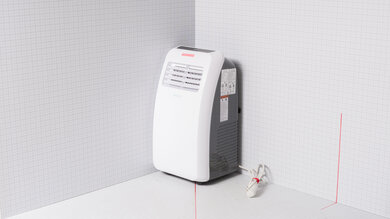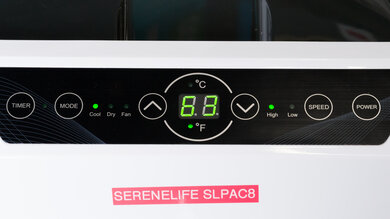The SereneLife SLPAC8 is a portable air conditioner designed for small spaces. It has a 4,000 BTU cooling output and an advertised coverage of 215 ft² (20 m²). It has a single hose design and three operating modes: cooling, dehumidifying, and a fan setting. It also has a remote control, but unlike more expensive A/C units, it isn't Wi-Fi enabled, so there's no smartphone app functionality or support for smart home integration.
Our Verdict
The SereneLife SLPAC8 is a poor choice for cooling large rooms. Its cooling capacity is very low overall; simply put, it won't be able to reduce the temperature in a large space to a reasonable level within an acceptable time frame. Its single-hose design is also pretty inefficient from a power-consumption standpoint.
-
Maintains consistent temperature and humidity levels.
-
Poor overall maintenance and cooling efficiency.
-
Very low overall cooling capacity.
-
High operating noise.
-
Constant running places increased wear and tear on components.
The SereneLife SLPAC8 is a mediocre option for use in small rooms, but nothing more. There's minimal difference in operating noise between its highest and lowest settings with the compressor turned off, which can keep you up if you were to leave it running overnight. On the upside, as a relatively compact caster-mounted portable unit, you can roll it around in your bedroom without too much effort. There's no smartphone connectivity, but it does come with a remote control that allows you to operate the unit without having to roll out of bed.
-
Compact dimensions.
-
Poor overall maintenance and cooling efficiency.
-
The non-inverter compressor will result in inconsistent temperature and humidity levels in appropriately-sized rooms.
-
High operating noise.
-
Constant running places increased wear and tear on components.
The SereneLife SLPAC8's overall efficiency is poor. Like any single-hose design, it'll have to work harder than other portable A/C unit designs to offset the heat from warm air that it draws in while running, driving up power consumption in exchange for only limited overall cooling capacity.
-
Poor overall maintenance and cooling efficiency.
Due to its low capacity, the SereneLife SLPAC8 is seldom at risk of being oversized for most spaces. Its compressor is forced to run almost continuously in larger spaces. This helps minimize humidity and maintain a stable temperature, with no drastic swings due to compressor cycling. However, forcing the unit to run continuously in areas that exceed its capacity places additional unnecessary wear and tear on its components. Its single-hose design is also highly inefficient, driving up its own power demands.
-
Maintains consistent temperature and humidity levels.
-
The non-inverter compressor will result in inconsistent temperature and humidity levels in appropriately-sized rooms.
-
Constant running places increased wear and tear on components.
The SereneLife SLPAC8 is a noisy A/C unit. While its operating noise can be partially masked by a TV playing nearby, its fan speed is rather loud, even at its lowest setting. This can make it a bit of a nuisance if you were to leave it running overnight while trying to get some rest.
-
High operating noise.
- 5.1 Large Room
- 6.2 Bedroom/Small Room
Performance Usages
- 4.9 Combined Efficiency
- 7.5 Oversizing Tolerance
- 4.4 Noise
Changelog
Differences Between Sizes And Variants
The SereneLife SLPAC8 is only available in a single color variant: 'White.' For those interested, here's the product label.
Let us know in the comments if you come across another variant of this air conditioner.
Compared To Other Air Conditioners
The SereneLife SLPAC8 is a simple, portable A/C unit. Its single-hose design already puts it at an inherent disadvantage in terms of cooling efficiency compared to a double-hose portable unit or a basic window A/C with similar capacity, such as the Toshiba RAC-WK0512CMRU, which has no effective way of exhausting compressor waste heat from the room it's cooling. If you truly need a portable unit and are dead-set on a cheaper single-hose model, the Black+Decker BPAC12HWT offers greater overall capacity and significantly lower operating noise.
The Black+Decker BPACT12HWT is a better portable A/C unit than the SereneLife SLPAC8 for the most part. The Black+Decker offers significantly more cooling capacity in a roughly similarly-sized package, all the while producing less noise. The SereneLife's lower capacity can work to its advantage in oversized spaces, in the sense that its compressor being forced to work constantly will minimize swings in humidity and temperature. However, this also increases energy requirements and places more wear and tear on the unit.
The SereneLife SLPAC8 and De'Longhi Pinguino Compact PACEM360-6ALWH each have their own strengths. The SereneLife is a little more compact and is marginally more power efficient when it comes to cooling and maintaining a setpoint. However, it's still far from spectacular in this respect. Meanwhile, the De'Longhi runs noticeably quieter, especially at its lowest cooling setting.
Test Results
This A/C unit comes bundled with an extending window bracket that can be locked at any length, rather than having a set of pre-drilled holes. This provides a lot of additional flexibility in terms of where you can set up the unit.
The SereneLife SLPAC8's cooling capacity is poor. This unit was unable to reach the desired 21 °C (69.8 °F) target from a 28 °C (82.4 °F) starting point without our maximum time allotment of 70 minutes. As a result, it'll take quite a while to cool the air even in smaller bedrooms, and it won't be able to reduce the temperature to your desired level in bigger spaces within a reasonable time frame.
This unit's efficiency while cooling is poor. This is a single-hose model, which intakes indoor air while cooling: this generates negative pressure inside the room it's placed in, and allowing warm outside air to leak in. This forces the unit to work even harder to offset this heat. It consumes far more energy than a window-mounted unit with a comparable cooling capacity, like the Toshiba RAC-WK0512CMRU, which places the heat-generating elements of its design outside of the space you're attempting to cool.
The SereneLife SLPAC8's temperature maintenance efficiency is bad. Its single hose design draws in air from the room it's cooling, drawing in warm outside air. As a result, the unit has to work hard to maintain the desired temperature.
This unit does a great job of maintaining humidity levels. As a low-capacity portable unit, its compressor needs to run constantly to cool even smaller spaces. This minimizes any swings in humidity levels, but also puts more wear and tear on its compressor.
This A/C unit occasionally exhibits noise spikes that climb to a very noticeable 78 dBA, though these bursts last less than a second. This can be very disconcerting in smaller spaces.



